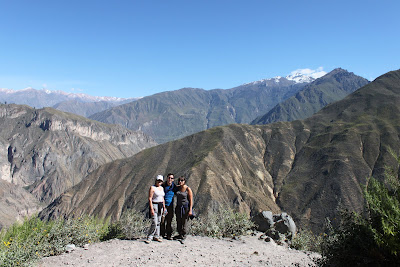Arequipa cathedral by night
We arrived early in the morning after a 10-hour night bus from Cusco. Arequipa feels warmer. We're a lot lower than Cusco and the atmosphere is different - possibly a lot more Peruvian - i.e. there are a lot less tourists (or at least they're diluted by the large local population). The streets are full of taxis, the buildings are brilliant white and there's a huge Plaza de Armas. That's about it. It feels a lot like Sucre, Bolivia.
Santa Catalina monastery

The monastery (http://en.wikipedia.org/wiki/Santa_Catalina_Monastery) is pretty much the main thing to do here... and that's no disadvantage. It is a walled city of its own, a labyrinth of little streets, courtyards and rooms (or cells), which took a good few hours to get around. Each part filled with flowers, painted a different colour and devoid of tourists. Apparently it's in the book '1,000 places to see before you die'. I can see why.
Up until the seventies it used to be a completely secluded community, just a few hundred nuns until they opened it up. It is still a convent with a section consisting of less than a hundred still living there, isolated from the bustling city outside.
The bus ride the following day to the Colca Canyon (http://en.wikipedia.org/wiki/Colca_Canyon) was an endless expanse of steppe, much like Patagonia - miles and miles of nothing, but with snow capped mountains and volcanoes in the distance extending to deep lush valleys, Inca terraces and ultimately the Colca Canyon - the second deepest in the world (and no the Grand Canyon is not the first).
It's nice to get the local buses when you can - people selling all sorts - soft drinks, sweets, text books, as well as musicians singing traditional songs with a panpipe and guitar in hand. However, it usually takes a lot longer than anticipated and they tend to fit more people in the bus than it can possibly carry (particularly un-nerving when traversing the narrow mountainous roads).
We arrived at our final destination, Copanaconde, by about 8 o'clock once the sun had set and checked into the first hotel / hostel we could find. It had turned what we thought would be a gentle afternoon excursion, into a day's travelling, more or less. We were lucky - the hotel / hostel seemed to be the nicest place in town (although the food was pretty crappy) and the lady running place was mad as a hatter.
The next morning it was an early start, a three-hour steep descent of more than 1,000 metres into the canyon and a couple of hours nursing our legs and admiring the view surrounded by mountains, a swimming pool and a fully stocked bar, before tucking into a square meal of alpaca and vegetables. It was easy trekking but without the early morning start (some tours start at 1am), the crap food and the physical pain.

We then took mules to the top - very much in keeping with our 'take-it-easy' outlook. I was reluctant at first, but came round within seconds going up - it was two hours and the mules didn't stop once, panting and sweating their way to the top. I'd have been panting and swearing my way to the top!

Gemma (G) = happy / mule (M) = knackered ( G = :) / M = :( )
It also meant that you could fully appreciate the beautiful scenery and acknowledge the precipitous drops and precarious footpath.
It was a good day - the weather was great and because we weren't in a large tour group it was un-touristy. In fact, it was only us going down and the odd stick-thin rambler coming up.
The bus trip back the next morning was easy. A public bus to a place called Cruz del Condor to view the birds hovering over the canyon (they have a wingspan of more than three metres) followed by a gringo bus back to Arequipa. My mum remarked that the birds look like black bin liners in the sky...beautiful!

Majestic gigantic feathered creature or bin bag blowing in the wind?
On our journey back to Arequipa we took in a natural hot spring at Chivay, tasted Colca sours (made from the fruit of a local cactus), ate a big buffet lunch and took in yet more barren but beautiful scenery (at a dizzying height of more than 4,800 metres).


No comments:
Post a Comment